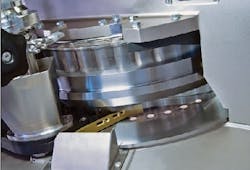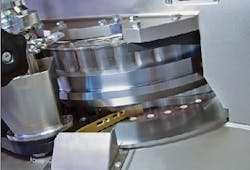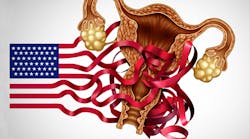Looking back on the history of the pharmaceutical industry, it’s very much an evolving practice, with new knowledge bringing continuous improvements. Copious trial and error has brought us an industry very different from that of 150 years ago. And yet, one methodology has survived the decades essentially intact. The basic oral solid dose manufacturing methodology used today is very similar to the OSD manufacturing of the past — and that’s not necessarily a bad thing.
In 1843, British painter/author/inventor William Brockedon patented an invention that compressed sodium carbonate and potassium carbonate in a tube, to form solid tablets. Eliminating the need for moisture to bind ingredients in the pill making process, Brockedon’s invention ushered in a completely different type of “pill” — one that could be mass produced in different dosage forms.
And while the dosage form has not seen what OSD subject matter expert Dave DiProspero calls a “silver bullet change,” the sector has continued to stay relevant.
2015:
23 of the 45 NMEs were solid dose products (51%)
15 tablets, 8 capsules
2014:
19 of 41 NMEs were solid dose products (46%)
10 tablets, 9 capsules
2013:
17 of the 27 NMEs were solid dose products (63%)
12 tablets, 5 capsules
*Information courtesy of U.S. FDA
In terms of oral-solid-dose facility construction, DiProspero, a senior consultant for CRB Consulting Engineers and also a leading committee advisor for ISPE’s Oral Solid Dose Community of Practice, notes that changes to the OSD sector have been “more along the lines of moderate upgrades and improvements to the process/facility. Not a lot of significant changes.”
“Over the past few years there has been a slowdown in ‘new’ OSD facilities. We are not seeing a lot of greenfield, let’s-build-a-100,000-square-foot-OSD-facility type projects (though there are a couple). However, renovating and upgrading of processes and technologies in OSD remains relatively strong. Companies are still investing in projects and working to upgrade existing facilities,” says DiProspero.
[javascriptSnippet ]
Despite the solid dose slowdown, and the noticeable attention being given to newer, flashier biologics initiatives, pharma is still investing in solid dose capabilities. Capsugel, for example, recently completed construction on a $25 million spray-dried dispersion (SDD) commercial facility in Bend, Oregon (discussed in detail here). Capsugel, now with the largest SDD facility in North America, is solving a number of different formulations and stability challenges faced with capsule and tablet dosage forms. In another example, prescription opioid pioneer Purdue Pharma invested big in the construction of a new 190,000-square-foot, oral-solid-dosage manufacturing plant in Durham, N.C., in 2014. The company is currently expecting to file for full manufacturing approval from the FDA in the second half of this year.
OSD GENERICS
With the large number of oral solid dose drugs plunging off the inevitable patent cliff, generic solid dose products have stepped in, poised to compensate for any future decline in OSD NMEs. As the role of generics in the OSD sector continues to grow, so does the regulatory scrutiny of generic solid dosage products. With 86 percent of all prescriptions in the United States now filled by a generic drug products, the Office of Generic Drugs began to notice that many ANDAs were being submitted to the FDA with tablets and capsules that were much larger in size than the reference product. While the generic formulations of these drug products are required to be both pharmaceutically and therapeutically equivalent to a reference listed drug (RLD), the agency was concerned that differences in physical characteristics of solid dose generics (size, shape, weight) would affect patient compliance and cause medication confusion.
Natoli’s rotary tablet press can deliver up to 5,500 tablets per minute with increased size and weight.
In response to these concerns, FDA released a draft guidance document of “nonbinding” recommendations in 2013, which was finalized in June 2015. The “Size, Shape and other Physical Attributes of Generic Tablets and Capsules” guidance pushes generic OSD manufacturers to take a closer look at the same factors brand manufacturers have been dealing with for decades. This guidance implies that as the FDA reviews new generic drug applications, physical characteristics will start being considered alongside pharmaceutical equivalence and bioequivalence.For generics manufacturers, this means making adjustments to compression equipment, staying current with OSD technologies and just a general “stepping up” of OSD techniques in regards to determining and regulating the measurements of tablets and capsules.
CONTAINMENT CONSIDERATIONS
According to DiProspero, in an industry where so much emphasis and regulatory focus is on the quality of the final product, it’s important to remember that there are “other factors aside from the final dosage form that need to be closely examined from the manufacturing standpoint.” Two such factors are environmental and operator protection during the manufacturing process.
Growing demand for more potent active pharmaceutical ingredients, as well as for toxic APIs for hormone and oncology drugs, means containment issues continue to be a crucial aspect of solid dosage manufacturing. According to GEA Pharma Systems, containment is an issue in 9 out of 10 cases of solid dosage form production. As the industry’s knowledge of potent and toxic compounds increases, with that comes the responsibility of monitoring and limiting exposure to manufacturing personnel.
Containment strategies need to address both operator exposure and cross-contamination issues. For the OSD sector, this means sophisticated equipment, such as containment technologies, HVAC systems and airlocks, proper facility design, protective equipment for workers, and comprehensive training and SOPs.
Last year, CMO giant Catalent further expanded its highly potent handling platform with an investment in contained oral solid manufacturing at its Somerset, NJ, headquarters. Catalent’s high potency containment strategy (discussed in detail here) starts with API categorization. The Catalent compound categorization code, developed in partnership with Safebridge Consultants, is applied across all global Catalent sites. When Catalent receives a new compound, operators determine which of the four categories it fits into, and this, in turn, informs all handling requirements.
CONTINUOUS DEBATE
The ongoing discussion regarding the degree to which continuous manufacturing should be applied to the manufacturing process is healthy in the oral solid dose sector.
The need to improve process efficiency, cut costs and improve quality is undeniable. “If you look at it from an operational efficiency standpoint, OSD manufacturing has a long way to go in comparison to other industries. Pharma needs to find ways to eliminate the many sub-step/no-value added operations and the many quality holds in its processing methods,” says DiProspero.
But is continuous manufacturing the cure-all? There are certainly benefits to CM, including a greater control over the quality and consistency of the products. Additionally, concerns associated with material handling, scale-up and production floor space commonly found in a batch process are largely resolved by continuous operations. But most experts agree that it’s just one tool in the efficiency arsenal.
“I see continuous manufacturing being an element of OSD facilties of tomorrow — not necessarily replacing traditional processes, but in addition to, the way we currently operate,” confirms DiProspero.
Gilad Langer, director of automation & MIS for NNE PharmaPlan, is more hesitant. “Before we latch on to a golden notion, we need to think it through. There needs to be a compelling business case for continuous manufacturing — it’s a huge investment and highly specialized.”
The continuous manufacturing paradigm continues to face manufacturing and development-based challenges. A primary discriminating parameter in the decision to go continuous is associated with production volume. Production of large volumes of solid material in a pharmaceutical environment is a challenge for batch and strongly points toward adapting a continuous processing solution, whereas manufacturing smaller volumes of multiple products in the same production facility on shared processing equipment introduces challenges for continuous processing.
There is a growing amount of real-world evidence that continuous processing is a viable approach to manufacturing OSD therapies, however. Last year, Janssen Pharmaceuticals and its corporate parent, Johnson & Johnson, announced production of daily HIV med Prezista would transition from batch processing to continuous manufacturing at its Gurabo, Puerto Rico, plant. Firmly committed, Janssen aims to manufacture 70 percent of “highest volume” products using CM within eight years, increase yield by reducing waste 33 percent, and reduce manufacturing and testing cycle times by 80 percent.
AUTOMATION BALANCE
Continuous manufacturing can’t exist without automation, but automation does certainly exist even in plants that have not made the leap to continuous. Batch manufacturing is still the norm is oral solid dose production, and the individual automation of stages allows the overall process be maintained with minimal risk.
Fully automated tablet presses, paired with automated in-process tablet inspection, have brought greatly improved product consistency and quality to the process. Automated inspection systems facilitate greater process control. By capturing a continuous stream of data about products in real-time, this technology enables OSD manufacturers to improve both upstream operations and streamline downstream processes, immediately — a key necessity for the integration of Process Analytical Technology (PAT) initiatives.
Reduction of manual tasks means less chance of errors, but in specific scenarios, some argue it can also mean surrendering a level of adaptability. In a market where agility and operational flexibility are key, OSD manufacturers are searching for the right balance between manual and automated processes. Langer cautions against the notion of blanket automation: “You first have to clearly understand what your objectives are — then you can decide what level of automation is needed and how much flexibility you need to build into the process.”
Manufacturers producing high-volume, high-potency solid dose products have realized the benefits of more elaborate automation. With the growing number highly potent OSD products being manufactured, automation is critical to operator safety, limiting operator exposure to toxic ingredients.
A classic example is Pfizer’s NEWCON facility at Illertissen, Germany, winner of the overall 2008 ISPE Facility of the Year Award. To accommodate growing demand for smoking cessation drug Chantix, Pfizer designed a facility for processing highly potent pharmaceuticals. High process automation and online PAT technologies resulted in a manufacturing facility that Pfizer reports has 44 percent lower production costs and 66 percent less staff. The plant’s production equipment is located in a dedicated processing module and is automated to ensure that no dust from the highly potent Chantix production can escape from the manufacturing area. All of the process stages are controlled and monitored from a separate control room so that employees do not come into contact with dust. According to ISPE in 2008, “This extent of automation has not previously existed in containment production anywhere in the world.”
SERIALIZATION & DATA OVERLOAD
Drug counterfeiting remains a growing challenge facing the oral solid dosage sector. High-value products that can be duplicated with relative ease make OSD forms a prime target for counterfeiters.
With the 2015 DSCSA “phase-one” launch date passed, and the 2017 “phase-two” deadline looming, serialization efforts are well underway across the supply chain. Beginning in November 2017, pharmaceutical products must be “marked with a national drug code, serial number, lot number, and expiration date in machine-readable and human-readable form” — and most manufacturers report being ready to meet this deadline.
The 2016 RxTrace U.S. Pharma Traceability Survey, which polled companies across the U.S. pharma supply chain and their solution providers, indicated that the majority of respondents were ready for the deadlines they had faced in 2015 and were feeling confident that they have enough time to take action to meet the next deadline.
As manufacturers arm themselves for a new level of traceabilty, many are opting for off-the-shelf control and information technology — such as vision, printing and checkweighing equipment, MES software and information-enabled programmable controllers — that will not complicate the information transfer needed for new serialization legislation.
Ramping up automation, moving towards continuous manufacturing and striving to meeting serialization mandates all result in huge volumes of data, which means data management is more important than ever before.
Langer points to the DIKW (data, information, knowledge, wisdom) Pyramid in order to explain the importance of data management. This concept stresses the need to elevate data to information, and then giving this information context to form knowledge that can be acted on. “Manufacturers need to pull data from equipment and give it context, elevating data to information, and using that for operational excellence.”
OSD OF THE FUTURE
The challenges faced by biologics in terms of development and production costs, drug delivery and a more complex biosimilar approval process, equate to continued relevancy for oral solid dosage drugs. In order to best capitalize on opportunities, OSD manufacturers are recognizing a universal need to ramp up efficiency and reduce waste.
According to Langer, “What’s driving all these moments is operational excellence. Manufacturers need, from a business perspective, to operate much more efficiently. The reality is that manufacturers can get much more out of what they have in place already.”
Even if processes do not achieve full continuous manufacturing as industry defines it, steps in that direction — taken by both brand and generic OSD manufacturers — are proving to be of significant benefit across the industry.
Concludes DiProspero, “I am frequently asked about what the OSD facility of the future might look like. I believe that The Facility of the Future is going to be much more agile, flexible and efficient than it is today. How do we do that? Innovative design concepts, new technologies and unique solutions: pull that together – perhaps in the context of continuous manufacturing – and you’ve got something to take OSD into the next generation.”






